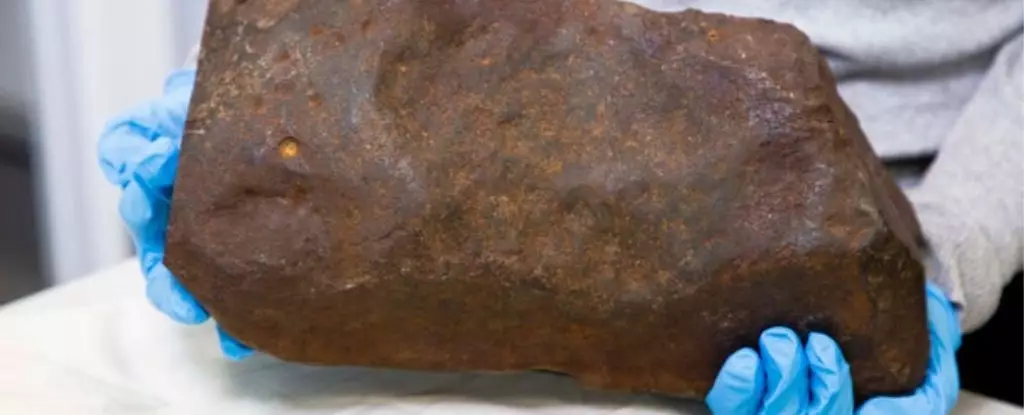In 2015, a routine day of metal detecting transformed into an extraordinary adventure for David Hole in Maryborough Regional Park, located near Melbourne, Australia. While searching for treasure, Hole encountered a substantial, compact object that piqued his curiosity. This heavy, reddish rock, nestled in a bed of yellow clay, ignited his imagination. Certain it concealed a golden lure within its stony embrace, he envisioned a chunk of history from the region famed for its gold rushes of the 19th century. This passionate pursuit to unveil the rock’s secrets led Hole to employ an arsenal of tools, including a rock saw, angle grinder, and even acid—yet every attempt ended in frustration.
What Hole did not realize was that his quarry was no mere gold nugget; it was a rare meteorite, a remnant of the universe’s ancient past. This revelation would take years to unfold, transforming what was once a simple curiosity into a significant scientific discovery.
David Hole eventually made a pivotal decision to take the object to the Melbourne Museum, seeking insight from experts. Geologist Dermot Henry assessed the find, describing its surface, which bore a sculpted, dimpled appearance formed by atmospheric entry—the hallmark of meteorites. Henry’s extensive experience in meteorite identification led him to a remarkable realization: this was a genuine specimen among the few that had been recorded. Indeed, during his lengthy career, he had encountered countless rocks misidentified as meteorites, making the Maryborough find exceptionally valuable.
Bill Birch, another geologist at the museum, highlighted the unusual heaviness of the meteorite, asserting that Earth rocks of similar size simply lack such substantial weight. This critical assessment underscored the object’s otherworldly origin, further cementing its importance in advancing our understanding of celestial materials.
Upon meticulously slicing the meteorite with a diamond saw for a detailed examination, researchers identified it as an H5 ordinary chondrite, an ancient remnant composed primarily of iron. This find weighed an impressive 17 kilograms (approximately 37.5 pounds) and dated back approximately 4.6 billion years, providing a window into the early solar system’s formation. The interior revealed striking crystallized droplets of metallic minerals known as chondrules, artifacts of the cosmic processes that shaped our planetary neighborhood.
Meteorites like the one discovered by Hole serve as invaluable time capsules, offering insights into the solar system’s history and the building blocks of life. Dermot Henry emphasized the significance of such specimens in scientific studies; they enable researchers to explore the conditions and materials present at the dawn of our solar system. Some meteorites even contain organic molecules that hint at life’s essential building blocks, deepening our understanding of life’s origins.
Tracing the Meteorite’s Journey
While the precise origins of the Maryborough meteorite remain undetermined, scientists speculate it likely formed in the asteroid belt, a region of space situated between Mars and Jupiter. The rock’s journey to Earth might have transpired through collisional events among asteroids, providing a glimpse into the dynamic dance of celestial bodies. Carbon dating estimates suggest the meteorite could have graced our planet for as little as 100 years or as much as 1,000 years, with historical meteor sightings between 1889 and 1951 hinting at its atmospheric entry.
The rarity of the Maryborough meteorite cannot be understated. In Victoria, it stands as only the 17th documented meteorite, firmly establishing its status as a scientific rarity—indeed, much scarcer than the gold which once enticed prospectors. This meteorite, following only a larger specimen found in 2003, impressively embodies a cosmic narrative few Earthbound items can replicate.
The saga of the Maryborough meteorite serves as an intriguing reminder of the mysteries that lie just outside our doorstep. With its fascinating backstory of misidentification and earthy adventures, one might feel compelled to scour their own surroundings for peculiar, dense rocks. After all, a seemingly ordinary find may very well harbor an extraordinary secret waiting to be unveiled.
As enthusiasts engage in the pursuit of buried treasures, the discovery of the Maryborough meteorite reinforces our connection to the cosmos. It illustrates how a single relic from space can bridge the gap between Earth and the universe, challenging us to consider the stories written in the stars and their relevance to our planet’s history. In the end, this remarkable meteorite transcends the allure of gold, embodying a treasure of scientific value with the potential to educate and illuminate future generations about the wonders of our solar system.


Leave a Reply